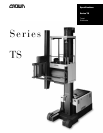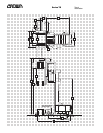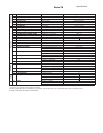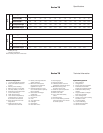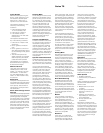
Series TS
Technical Information
Travel Speeds
Maximum travel speed on guid-
ance is: 6 mph (528 fpm) to 156"
fork elevation. Gradual speed
reduction to 1 mph at 372", 1
mph above 372" fork elevation.
Travel speed is limited to 1 mph
under any of the following
conditions:
1. Forks are elevated above
12" on the auxiliary mast.
2. Forks are not at full pivot.
3. Load handler traverse-
sideshift are not at clear-aisle
travel position.
Travel speed is disabled under
any of the following conditions:
1. Forks are not at full pivot and
above 240".
2. Not on guidance and above
240".
3. Not on guidance, forks not at
clear-aisle travel position above
93" and steering turned greater
than 10°.
4. The TN travel speed is dis-
abled, whenever out of guided
aisle and primary lift is raised,
unless otherwise specified.
Travel speeds not on guidance
are less than those on guidance
at elevated fork heights.
Wheels and Tires
Large, high-load capacity poly-
urethane press-on tires. Load
wheels - 15" diameter x 8" wide.
Drive Wheels - 13" diameter x
5.5" wide. Guide Wheels - 6" dia-
meter x 2" wide molded-on hub,
non-press-on.
Suspension
Four-point solid suspension with
long wheel base and wide spread
of load and drive wheels improve
truck capacity, reduce effect of
uneven floors, and improve floor
load distribution.
Forks--Fork Carriage--Turret
Carriage
Forks are incrementally adjustable.
Fork carriage pivots through 180º
permitting pickup and deposit
from either side or front. Cylinders
are equipped with hydraulic cush-
ion stops to automatically reduce
speed at end of pivot. Cross-over
relief valves reduce excess pres-
sure should forks be force-pivoted.
Pivot lock engages at full-rotated
position to prevent drift.
lights, palm switch light, open cab
door warning light, master service-
required light, service calibration
light, wire guidance field strength
light (optional), wire guidance
switch and status lights (optional),
parking brake switch with status
light, fork height limit override
button with light, and discharge
indicator with low voltage lift inter-
rupt to reduce truck and battery
maintenance.
Controls permitting emergency
fork movement are located below
the hinged arm rest pad. Horn
button, primary power emergency
disconnect and power key are
provided. All controls are located
convenient to the operator.
Storage pockets for work sheets
are provided. A two speed fan,
cab light and work lights front and
back, are located in the overhead
consoles.
Primary Mast
Elevated load sway due to mast
twisting, plus forward and side
bowing are minimized through
the use of closed cross-section
mast construction. Rolled “I”
beams continuously welded to a
flat and a formed plate create a
full length, deep cross-section
mast capable of resisting front
and side loading equally well. Lift
cylinders, hoses, cables and
chains within the mast are readily
accessible for service. Built-in
sensors detect slack chain and
shut down primary lower, auxiliary
lower, pivot and traverse functions.
Drive Units-Steering
Steerable dual drive units with
fixed mounted traction motors
minimize wear and maintenance
on electrical cables. Full electrical
power steering uses servomotors
for turning the drive wheels. Drive
wheels are automatically centered
on trucks equipped with aisle-
guide rollers.
Brakes
Two force levels of mechanical
braking provide smooth stopping.
This is achieved by the truck
automatically switching from four
wheel to two wheel braking at
slower travel speeds. Braking can
also be accomplished by propor-
tional plugging which permits the
operator to control rate of decel-
eration when a greater stopping
distance is acceptable.
Electrical
Heavy duty 72 volt electrical
power system reduces current
requirements for improved effi-
ciency. SCR controlled lift and
Auxiliary Mast
Turret carriage with forks can be
elevated on the auxiliary mast to
permit stacking close to the ceil-
ing. Operator can view the load
from the underside at full auxiliary
lift to aid load placement. Lift
cylinder, hydraulic hoses and
electrical cables are protected
within the profile of the structure,
or behind removable covers. Ver-
tical side alignment of the mast is
maintained by gear racks and
pinions. Lowering of auxiliary and
primary lift system will stop if
chains become slack.
Traverse and Sideshift
Traverse movement of the auxil-
iary mast and side movement of
the sideshift carriage are auto-
matically sequenced, requiring
only one operator control. Full
sideshift travel with built-in limits
is brought to a smooth stop by
hydraulic cushions. Withdrawal of
forks from the side-extended po-
sition automatically stops at the
travel position.
Operator Cab and Controls
Adjustable operator’s seat pivots
35° from a full side position toward
a forward position to provide visi-
bility to the front, rear or either side.
Lever controls permit all load
handling functions to be infinitely
controlled. Left hand control is
used for primary and auxiliary
raise and lower. Right hand pivot
and traverse controls can be
simultaneously operated for
pivoting the load in a minimum
amount of space. Movement of
the sideshift carriage is automati-
cally sequenced to the traverse
control. Integrated palm-pressure
buttons in the control knobs
require the operator to keep his
hands within the compartment
during any load handling function.
Programmable fork height limits
are available for raise and lower.
Both lower and one raise limit can
be overridden by the operator.
Steer wheel position indicator is
located next to the steering arm.
Forward and reverse travel is con-
trolled by a directional selector
and accelerator pedal. The truck
can be stopped by activation of
foot-operated brake, proportional
plugging, parking brake, emer-
gency disconnect or power key.
A control and feed back display
include indicator lights for forward
and reverse travel direction, load
handler clear aisle travel position
drive motors. Each controller
provides current limiting motor
protection in addition to the fuses.
Two on-board micro-computers
are integrated into the truck to
provide maximum load handling
through-put and smooth truck
performance. Serial data link
communications between the
elevated cab and the lower power
unit minimizes the number of
electrical conductors through the
mast. Long life solid state en-
coders and LVDT are used in
place of potentiometers. Travel
speed is sensed and regulated to
precise rate. Height sensor pro-
vides input for a programmed
gradual reduction in maximum
allowable travel speed as the pri-
mary lift is elevated. Maximum lift
and lower speeds are reduced
near full lift and lower to provide a
soft stop. On-board software in-
cludes truck calibration, system
diagnostics and trouble isolation
capabilities accessible by an
optional plug-in terminal.
Hydraulics
Maximum lowering speed is limit-
ed by pressure-compensating
flow controls and velocity fuses.
Integrated hydraulic cylinder
cushions bottom stop when low-
ering. All lift cylinder rams are
plated. Primary mast emergency
lowering valve and load handler
emergency power switch are
located in the power unit.
Other Options
1. Audible Travel Alarm.
2. Contact factory for additional
options.
Safety considerations and dangers
associated with audible travel
alarms include:
• Multiple alarms can cause
confusion.
• Workers ignore the alarms
after day-in and day-out
exposure.
• Operator may transfer the
responsibility for “looking out”
to the pedestrians.
• Annoys operators and
pedestrians.
Dimensions and performance
data given may vary due to manu-
facturing tolerances. Performance
is based on an average size vehicle
and is affected by weight, condi-
tion of truck, how it is equipped
and the conditions of the operating
area. Crown products and speci-
fications are subject to change
without notice.



